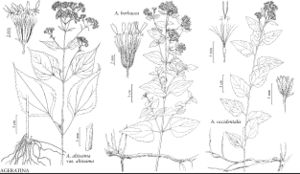Ageratina
Hist. Nat. Vég. 10: 286. 1841.
| Taxon | Illustrator ⠉ | |
|---|---|---|
 | Ageratina altissima var. altissima Ageratina herbacea Ageratina occidentalis | Linny Heagy Linny Heagy Linny Heagy |
Perennials, subshrubs, or shrubs [trees], mostly 20–220 cm. Stems usually erect, rarely scandent, sparsely to densely branched. Leaves cauline; mostly opposite (distal sometimes alternate); petiolate; blades 3 (–5) -nerved from bases, usually deltate, lanceolate, ovate, rhombic, or triangular, sometimes orbiculate, margins entire, crenate, dentate, or serrate, faces glabrous or hispidulous, pilose, or puberulent, sometimes glanddotted (A. occidentalis, A. adenophora). Heads discoid, usually in compact, (terminal and axillary) corymbiform arrays, sometimes borne singly. Involucres campanulate, 3–6 mm diam. Phyllaries persistent, 8–30 in 2 (–3) series, 0-nerved or 2-nerved, lanceolate to linear, ± equal (herbaceous). Florets 10–60; corollas white or lavender, throats obconic to campanulate (lengths 1.5–2 times diams.); styles: bases sometimes enlarged, glabrous, branches linear, seldom distally dilated. Receptacles convex (glabrous or hairy), epaleate. Cypselae prismatic or ± fusiform, usually 5-ribbed, scabrellous and/or glanddotted; pappi usually persistent, sometimes fragile, rarely falling, of 5–40, barbellulate bristles in 1 series. x = 17.
Distribution
North America, Mexico, Central America, Andean South America
Discussion
Species ca. 250 (14 in the flora).
Selected References
Lower Taxa
Key
| 1 | Shrubs | > 2 |
| 1 | Perennials or subshrubs | > 3 |
| 2 | Petioles (2–)3–5 mm; leaf blades 1–2 cm, margins entire or shallowly crenate, facesgland-dotted | Ageratina wrightii |
| 2 | Petioles 3–10(–15) mm; leaf blades (2–)3–5(–7) cm, margins coarsely crenate, facesnot gland-dotted | Ageratina havanensis |
| 3 | Leaves alternate on at least distal 1/4–1/2 of stems | > 4 |
| 3 | Leaves opposite | > 6 |
| 4 | Heads usually borne singly (rarely 2s or 3s); involucres 11–12 mm | Ageratina shastensis |
| 4 | Heads usually 5–10 (axillary clusters usually forming elongate or broad aggregates); involucres 2.5–3.5(–4) mm | > 5 |
| 5 | Leaves alternate on distal 1/4–1/2 of stems; involucres 3–3.5(–4) mm; corollas pink, bluish, or white tinged with purple (not orange-veined); cypselae sessile-glandular | Ageratina occidentalis |
| 5 | Leaves alternate (from bases to apices of stems); involucres 2.5–3 mm; corollaswhite (prominently orange-veined); cypselae eglandular | Ageratina thyrsiflora |
| 6 | Peduncles densely stipitate-glandular | Ageratina adenophora |
| 6 | Peduncles puberulent, glabrous, or glabrescent (not glandular) | > 7 |
| 7 | Flowering in spring; leaves usually narrowly lanceolate, 0.5–1.5 cm wide,apically long-acuminate; involucres 2.5–3 mm; cypselae glabrous | Ageratina paupercula |
| 7 | Flowering in fall; leaves ovate to lanceolate-ovate, triangular, or lanceolate, (0.5–)1.5–9 cm wide, apically acute to acuminate; involucres (in A. jucunda 2.5–)3.5–7 mm; cypselae usually hairy (glabrous in A. altissima) | > 8 |
| 8 | Leaves mostly sessile; heads in open, loose arrays, peduncles 10–60 mm | Ageratina lemmonii |
| 8 | Leaves distinctly petiolate; heads in compact clusters, ultimate peduncles 1–15(–20) mm | > 9 |
| 9 | Petioles 1–22 mm (distal leaves greatly reduced in size well proximal to heads); leaf blades 2–7(–9) × 1.5–4 cm (relatively thick) | > 10 |
| 9 | Petioles (5–)10–70 or 2–20 (in A. rothrockii) mm; leaf blades 2–11(–13) × 1.5–9 cm (relatively thin) | > 11 |
| 10 | Petioles 1–8(–12) mm; leaf margins crenate or less commonlycrenate-serrate to dentate or subentire | Ageratina aromatica |
| 10 | Petioles 7–15(–22) mm; leaf margins coarsely serrate or incised orless commonly crenate to subentire | Ageratina jucunda |
| 11 | Leaves (yellow-green or grayish yellow-green): blades triangular to lanceolate-ovate or ovate, 2–5(–7) × 1.5–3.5(–4.5) cm; phyllariesusually granular-puberulent | Ageratina herbacea |
| 11 | Leaves (green, rarely yellowish): blades lanceolate to lanceolate-ovate, 4–11(–13) × 2.5–9 cm; phyllaries glabrous, villous, or villous-puberulent | > 12 |
| 12 | Stems glabrous; leaf blades broadly deltate-ovate (thin, delicate), apices obtuse; corolla lobes glabrous or sparselypuberulent | Ageratina luciae-brauniae |
| 12 | Stems puberulent; leaf blades deltate-ovate to ovate or broadly lanceolate, apices acute to acuminate; corolla lobes short-villous | > 13 |
| 13 | Peduncles 1–5 mm; involucres 4–5 mm; cypselae glabrous;e United States and Canada | Ageratina altissima |
| 13 | Peduncles 5–12(–20) mm; involucres 5–7 mm; cypselae sparsely and finely strigose-hirsute; Arizona, New Mexico, sw Texas | Ageratina rothrockii |
"fine" is not a number.